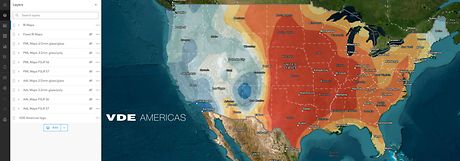Naturally occurring hail return interval maps in ArcGIS Online
VDE Americas' hail return interval data covers the Continental United States (CONUS) and is available as an organization-level subscription. This set of data includes the return interval (RI) in years for naturally occurring hail (NOH) ranging in diameter from 25 mm (1 in.) to 95 mm (3.7 in.) and the maximum estimated hailstone diameter (dmax) for cumulative return intervals (e.g, 40 years or 100 years). The return interval metric characterizes the estimated amount of time between discrete events. Typical return interval periods for this data set include <25 years, 25–50 years, 50–100 years, 100–250 years, 250–500 years, 500–1,000 years, 1,000–5,000 years, and ≥5,000 years. Our meteorological model combines calibrated Next-Generation Radar (NEXRAD) data with observed hail records maintained by the NOAA Storm Prediction Center. The resulting geospatial hail risk data sets are visualized as contour maps.
Hail return interval data are especially useful for characterizing the maximum expected hailstone diameter over an asset's operational lifetime. For example, VDE Americas uses naturally occurring hail return interval data to inform engineered probable maximum loss (PML) and average annual loss (AAL) estimates for utility-scale solar farms. These same hail return interval data can also help insurers, risk advisors, technical advisory firms, and other service providers understand location-specific hail risk, which affects agriculture (crops and livestock), transportation (car dealerships), and the built environment (homes, businesses, and civic facilities) throughout the CONUS.






